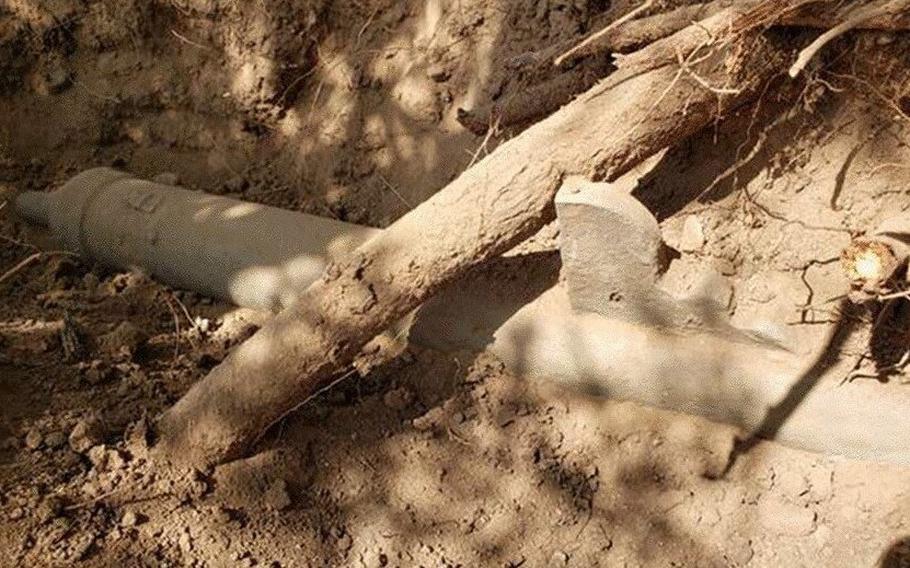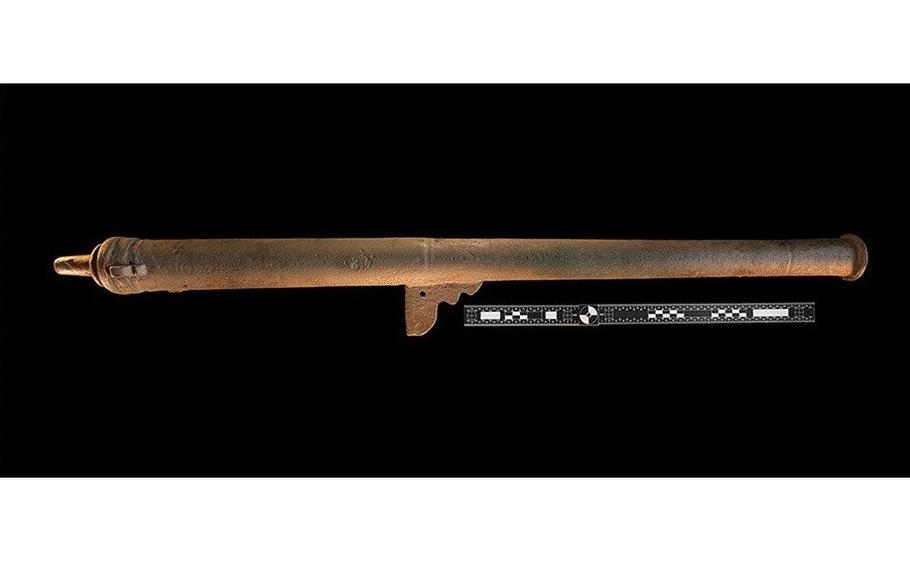
A bronze cannon was found underground in Arizona about 500 years after researchers said it was made. (Deni Seymour)
After archaeologist Deni Seymour found the rarest artifact of her career, her excitement turned to worry that she would be investigated by police.
She had unearthed a 3½-foot bronze cannon in Nogales, Ariz., near the U.S.-Mexico border. Seymour and her colleagues placed it atop a beige bedsheet and carried into the back seat of her Jeep Wrangler. She had to pass a Border Patrol station on her drive home, she said, and she didn’t know how she would start to explain why she had a 500-year-old firearm.
“If that thing got taken,” Seymour said, “I might not ever see it again.”
Seymour escaped with the roughly 40-pound cannon, which she said was probably built in the early 1500s and was carried by Spanish explorers to North America a few decades later. Seymour, who published her findings in the International Journal of Historical Archaeology last month, said the cannon is the oldest firearm that’s been found in the continental United States.
The cannon, also referred to as a wall gun, often was placed on a large wooden tripod and was operated by two people. It could fire buckshot — which researchers said sprayed opponents like a swarm of hornets — and lead balls, which were used to destroy thin walls. Gunmen placed priming powder on a flat ledge near the touch hole, and the cannon ignited with a slow-burning match cord.
Firearms are now more deadly than ever and can be purchased without a license in many U.S. states. “Ghost guns” can even be built by anyone. But the cannon Seymour discovered is believed to be among the first portable firearms.
“An artifact like this can connect people to the past, to history, and really stirs their imagination,” Seymour, 66, told The Washington Post.

Researchers recently found this bronze cannon. (Deni Seymour)
Seymour began searching for 500-year-old artifacts in Southern Arizona in July 2020. She hoped to find items from the expedition of Francisco Vázquez de Coronado, a Spanish explorer who traveled north in the mid-1500s from what is now Mexico in search of mythical cities and a route to Asia. He traveled with hundreds of soldiers and enslaved people and established one of the first European settlements, which explorers called San Geronimo III, located near the modern day Santa Cruz River.
Vázquez de Coronado’s team reached as far north as Kansas before returning to Mexico — probably after losing in battle to Native Americans who lived on the land. Seymour’s research could help fill in the missing pieces of that ill-fated expedition, including whether they made camp in Arizona - and what happened to the Spaniards there.
Items believed to stem from their expedition — caret-headed nails from horses, the head of crossbow bolts and musket balls — had been found in New Mexico and Texas, but Seymour wanted to learn if the explorers also traveled through Arizona.
Using metal detectors near the Santa Cruz River, Seymour and her team dug up equipment they believed belonged to the Spanish explorers — a rowel spur, European pottery, and fragments of olive jars, which Spanish colonies used as storage and shipping containers. She said she believed she was in San Geronimo III.
In September 2020, Seymour was digging in Nogales when she said she struck something that looked like bronze or copper. She thought it might’ve been a bell.
“What in the world is there?” she asked a colleague, according to a video Seymour took of the discovery.
As she kept digging through dirt, Seymour said it became clear that the item was wider than a bell. Then she saw parts of a firearm — a touch hole and a barrel. After uncovering it, Seymour said she and a colleague marveled at their discovery for a few minutes.
“I was in shock,” she said. “It was just an odd feeling that I rarely get.”
While historians haven’t agreed on an exact date that firearms came to the United States, some researchers had believed that guns first came to the area in the early 1600s, when European colonizers traveled to the Americas in force. A metallurgical analysis found that the cannon’s materials were from the early 1500s, Seymour said.
There was no black residue in the cannon’s barrel, Seymour said, so it was probably never fired. By the mid-1500s, some soldiers no longer used portable cannons, instead carrying lighter weapons such as wheellocks, muskets and matchlocks, Seymour said. But the cannon was still light enough for people, horses and mules to carry, according to researchers.
Explorers might not have had time to collect the cannon before retreating from attacks from Native Americans, Seymour said. Her team also found lead shot, parts of chain mail and plate armor and pieces of broken swords and daggers near the cannon, supporting the theory that a battle occurred there.
Matthew Schmader, an adjunct archaeology professor at the University of New Mexico who wasn’t involved in the study, said there are still unknown parts of the Spanish expedition that Seymour’s research could help answer.
“It may help to fill out some of the missing details of, not only some of the material and the weaponry, but also that area,” Schmader said. “Because that particular area, that portion of the expeditionary route, is really pretty unknown.”
Seymour said the cannon is in a secure area but will eventually be displayed at a museum. She has continued searching southern Arizona for materials, and in March, she said she found another cannon that’s designed similarly to her first discovery. She still hopes to find skeletons, animal bones and more parts of adobe-and-stone buildings that Spanish explorers often built.
“The cannon is pretty darn wonderful, but each artifact we find and the context of them has the potential to convey a really interesting part of the story,” she said. “And that’s what’s fun about it. That’s what’s interesting, and that’s what keeps me going.”